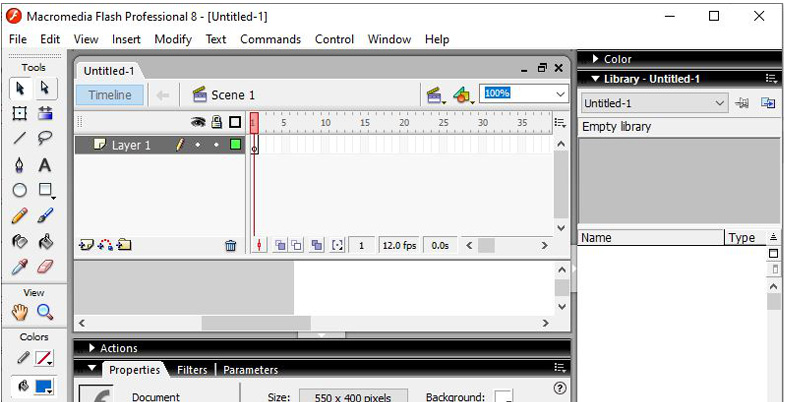Guide to Setting Up Website Email on Mobile and Computer
Follow the guide to set up your domain email on any device or OS, including both smartphones and computers, quickly and easily.

What is the popular Flash program? I will examine its history, created by Macromedia Flash, which was later changed to Adobe Flash Player.
Flash technology for producing animated images for websites was founded in the web world by Macromedia, which was introduced with the Adobe trademark when Macromedia was purchased by Adobe.
The basis of the structure of Flash SWF files is in the form of vectors (Vector-Base), which are controlled and commanded with the ActionScript language of contents and objects (Object).
Simplicity in controlling content and information, high graphics, and great flexibility have led to its widespread use.
Today, Flash Player is enabled and installed on 90% of computers connected to the Internet.
Flash technology was one of the most prominent tools on the web in the past decades.
This technology, which was first developed by Macromedia and then known as Adobe Flash when the company was purchased by Adobe, was used for years as the main pillar of multimedia content production on the Internet.
At a time when the Internet was still in its infancy and modern standards like HTML5 and CSS3 had not yet matured, Flash enabled the creation of light animations, online games, dynamic advertisements, and even video playback in browsers.
But as the history of technology has shown many times, every product declines after a period of prosperity for various reasons.
Despite its unparalleled role in the evolution of the web, Flash was finally officially retired in 2020, giving way to modern technologies.

The roots of Flash date back to 1993, when a small company called FutureWave introduced software called SmartSketch.
This software was originally a vector design tool.
A few years later, as the web grew in popularity, FutureWave decided to redesign its software for producing web animations and named it FutureSplash Animator.
In 1996, Macromedia acquired this product and marketed it as Macromedia Flash.
This name change marked the beginning of an era that made Flash one of the most popular web technologies.
After Adobe acquired Macromedia in 2005, Flash continued to exist as Adobe Flash Player and became almost an unwritten standard in browsers in the 2000s.
Due to its vector structure, Flash allowed for the creation of smooth, lightweight animations.
This feature was a great advantage in an era when internet speeds were slow.
Therefore, flash applications expanded rapidly and were used in various fields.
One of the most important uses of Flash was in website design.
Interactive websites with animated menus, dynamic advertising banners, and attractive graphic effects were mainly built with Flash.
Also, many online browser games were designed based on Flash and attracted millions of users.
Furthermore, Flash was the primary tool for playing video in browsers before web video standards became widespread.
Services like YouTube relied on Flash to display videos in their early days.
Flash was not just a graphical tool, but with its own programming language, ActionScript, it was able to create an interactive and dynamic environment.
ActionScript allowed developers to design interactive buttons, input forms, complex games, and web applications.
This language evolved over time and acquired features similar to the common programming languages of the time.
As a result, Flash became a complete platform for combining graphics, sound, video, and programming logic.

Flash was almost everywhere in the first decade of the 21st century.
According to official statistics, more than 90 percent of computers connected to the Internet had Flash Player enabled.
Several key factors contributed to this success:
First, Flash provided designers with a simple solution for creating multimedia content.
Second, SWF files were small in size and loaded much faster than traditional animated images or raw video.
Third, the visual appeal of Flash-based websites attracted users' attention and brands used it for advertising and marketing.
All of these factors came together to make Flash the dominant technology of the web.
Despite its widespread popularity, Flash gradually faced serious challenges.
One of the biggest problems was security issues.
Numerous security holes in Flash Player allowed hackers to attack users' systems through infected websites or files.
These problems became so widespread that many security experts described the use of Flash as risky.
In addition to security, high consumption of hardware resources was another weakness of Flash.
Running complex Flash files would slow down the browser, increase RAM usage, and even heat up the processor.
With the spread of smartphones, this problem became more apparent, as mobile devices had more limited processing power than personal computers.
The turning point in Flash's decline can be considered 2010, when Steve Jobs, then CEO of Apple, explicitly stated in an article titled My Thoughts on Flash that the iPhone and iPad would never support Flash.
He cited high battery consumption, weak security, and poor performance on mobile devices as his reasons.
Apple's decision sparked a wave of criticism and at the same time, reviews in the technology industry.
As time passed and new standards like HTML5 emerged, Flash's position became increasingly shaky.
Major browsers like Chrome, Firefox, and Edge have gradually limited support for Flash.
Finally, Adobe announced in 2017 that it would end support for Flash by the end of 2020.
This decision was implemented on December 31, 2020, and thus, Flash officially became history.
The advent of HTML5 marked the end of Flash's dominance.
This new standard allowed video, audio, and graphics to be displayed directly in the browser, without the need to install third-party plugins.
In addition to HTML5, technologies such as CSS3 and JavaScript also played a key role in replacing Flash.
CSS3 provided designers with extensive capabilities for designing animated graphics and visual effects.
JavaScript, with its numerous libraries and frameworks, has also revolutionized the interactive part of the web.
WebGL also made it possible to run 3D graphics in the browser without the need for plugins like Flash.
The result was that the combination of HTML5, CSS3, JavaScript, and WebGL became a powerful and secure platform for producing multimedia content.
Comparing Flash with modern technologies shows that although Flash was very advanced for its time, it had serious limitations.
Low security, dependency on plugins, high resource consumption, and lack of full compatibility with mobile devices were among its problems.
In contrast, new technologies based on web standards are not only lighter and more secure, but are also natively supported in browsers.
This has improved the user experience and allowed developers to implement their projects more easily.
Source » Itroz Blog


Follow the guide to set up your domain email on any device or OS, including both smartphones and computers, quickly and easily.

This guide is useful for automatically forwarding your website emails set up on your domain to other email accounts, such as Gmail and others.

Step-by-step guide to install Thunderbird on macOS; download, setup, and manage multiple email accounts easily and efficiently.
Comments (0)